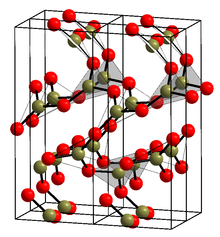삼산화 붕소
(삼산화이붕소에서 넘어옴)
삼산화 붕소(boron trioxide) 또는 삼산화 이붕소(diboron trioxide)는 화학식 B
2O
3를 갖는 붕소의 산화물이다. 무색 투명한 고체이며 거의 항상 유리질(무정형)이며 결정화하기가 매우 어렵다. 산화붕소 또는 보리아라고도 한다. 이는 주로 유약과 에나멜용 플럭스로서 세라믹과 유리 생산에 중요한 산업 응용 분야가 많다.
![Crystal structure of B2O3[1]](http://upload.wikimedia.org/wikipedia/commons/thumb/d/d9/B2O3powder.JPG/220px-B2O3powder.JPG)
| |

| |
| 이름 | |
|---|---|
| IUPAC 이름
Diboron trioxide
| |
| 별칭
boron oxide, diboron trioxide, boron sesquioxide, boric oxide, boria
Boric anhydride | |
| 식별자 | |
3D 모델 (JSmol)
|
|
| ChEBI | |
| ChemSpider | |
| ECHA InfoCard | 100.013.751 |
| EC 번호 |
|
| 11108 | |
PubChem CID
|
|
| RTECS 번호 |
|
| UNII | |
CompTox Dashboard (EPA)
|
|
| |
| |
| 성질 | |
| B2O3 | |
| 몰 질량 | 69.6182 g/mol |
| 겉보기 | white, glassy solid |
| 밀도 | 2.460 g/cm3, liquid; 2.55 g/cm3, trigonal; |
| 녹는점 | 450 °C (842 °F; 723 K) (trigonal) 510 °C (tetrahedral) |
| 끓는점 | 1,860 °C (3,380 °F; 2,130 K) ,[2] sublimes at 1500 °C[3] |
| 1.1 g/100mL (10 °C) 3.3 g/100mL (20 °C) 15.7 g/100mL (100 °C) | |
| 용해도 | partially soluble in methanol |
| 산성도 (pKa) | ~ 4 |
자화율 (χ)
|
−39.0·10−6 cm3/mol |
| 열화학 | |
열용량 (C)
|
66.9 J/(mol⋅K) |
표준 몰 엔트로피 (S
|
80.8 J/(mol⋅K) |
표준 생성 엔탈피 (ΔfH⦵298)
|
−1254 kJ/mol |
기브스 자유 에너지 (ΔfG˚)
|
−832 kJ/mol |
| 위험 | |
| 주요 위험 | Irritant[4] |
| GHS 그림문자 | 
|
| 신호어 | 위험 |
| H360FD | |
| P201, P202, P281, P308+313, P405, P501 | |
| NFPA 704 (파이어 다이아몬드) | |
| 인화점 | noncombustible |
| 반수 치사량 또는 반수 치사농도 (LD, LC): | |
LD50 (median dose)
|
3163 mg/kg (oral, mouse)[5] |
| NIOSH (미국 건강 노출 한계): | |
PEL (허용)
|
TWA 15 mg/m3[4] |
REL (권장)
|
TWA 10 mg/m3[4] |
IDLH (직접적 위험)
|
2000 mg/m3[4] |
달리 명시된 경우를 제외하면, 표준상태(25 °C [77 °F], 100 kPa)에서 물질의 정보가 제공됨.
| |
반응 편집
용융된 산화붕소는 규산염을 공격한다. 용기는 아세틸렌의 열분해로 얻은 흑연화 탄소층을 사용하여 내부적으로 부동태화할 수 있다.
같이 보기 편집
각주 편집
- ↑ Gurr, G. E.; Montgomery, P. W.; Knutson, C. D.; Gorres, B. T. (1970). “The Crystal Structure of Trigonal Diboron Trioxide”. 《Acta Crystallographica B》 26 (7): 906–915. doi:10.1107/S0567740870003369.
- ↑ 《High temperature corrosion and materials chemistry: proceedings of the Per Kofstad Memorial Symposium. Proceedings of the Electrochemical Society》. The Electrochemical Society. 2000. 496쪽. ISBN 978-1-56677-261-7.
- ↑ Patnaik, P. (2003). 《Handbook of Inorganic Chemical Compounds》. McGraw-Hill. 119쪽. ISBN 978-0-07-049439-8. 2009년 6월 6일에 확인함.
- ↑ 가 나 다 라 NIOSH Pocket Guide to Chemical Hazards. “#0060”. 미국 국립 직업안전위생연구소 (NIOSH).
- ↑ “Boron oxide”. 《Immediately Dangerous to Life and Health Concentrations (IDLH)》. National Institute for Occupational Safety and Health (NIOSH).
